The 2016 Razer Blade Pro Review
by Brandon Chester on March 6, 2017 8:00 AM EST- Posted in
- Laptops
- Razer
- Razer Blade Pro
System Performance
The Razer Blade Pro is not like the desktop replacement machines from Clevo and MSI, but it's still very much a mobile workstation. It's outfitted with 32GB of 2133MHz DDR4 memory running in dual channel mode, NVIDIA's GTX 1080 GPU, and an Intel i7-6700HQ CPU. At this point Intel's Skylake parts are a known quantity, and 6700HQ has shown up in a multitude of laptops over the past year. It's a 45 watt part with a base frequency of 2.6GHz and a peak turbo frequency of 3.5GHz. The Blade Pro launched a bit too early to use Kaby Lake, although Kaby Lake doesn't really bring a significant improvement in performance so it's not really an issue anyway. The implementation of G-SYNC means that the Intel HD 530 GPU is unused, so the Blade Pro is always working with the GTX 1080.
Even though we've tested many other machines that use i7-6700HQ, the different memory configuration and GPU in the Blade Pro make it worth running it through our standard suite of laptop benchmarks. Issues with x.264 getting stuck on the final pass prevented me from getting scores for that test, so I've opted to omit it and continue with PCMark, Cinebench, and our JavaScript web benchmarks.
PCMark

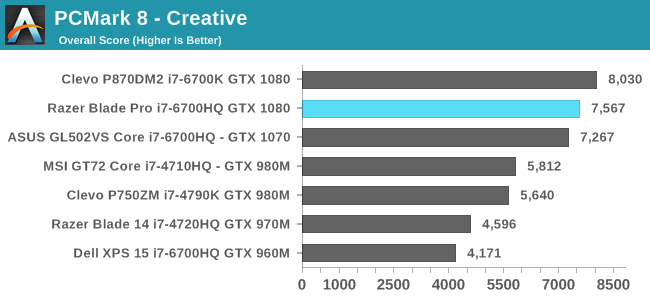
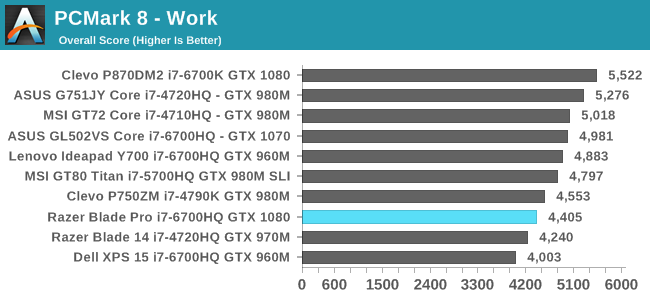
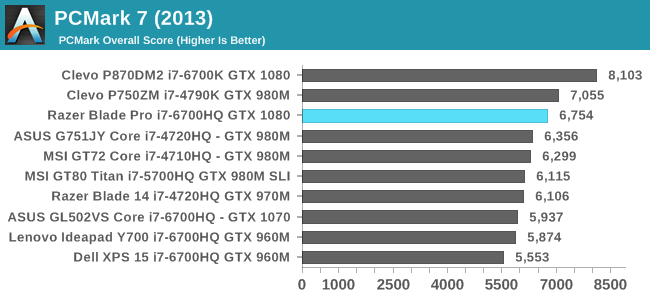
PCMark is a more holistic kind of benchmark than the other tests that we run. Many benchmarks focus on a single component, such as a JavaScript benchmark to evaluate single-threaded CPU performance or a gaming benchmark to characterize GPU performance, but PCMark attempts to measure the performance of a system when considering the interaction of components like the CPU, GPU, RAM, disk speed, etc.
In PCMark 8 the Blade Pro performs well in the Creative test suite, but doesn't perform as well in the Work or Home tests. However, it's important to note that the range of scores is much greater in the Creative test, putting the Blade Pro with its GTX 1080 ahead of most other laptops. In the other two tests the score is on the lower end, but it's still similar to those from other laptops that use i7-6700HQ.
Cinebench
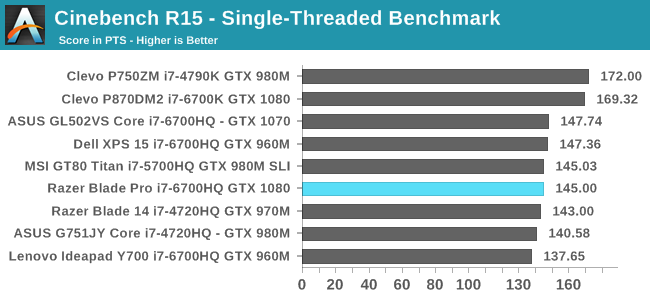
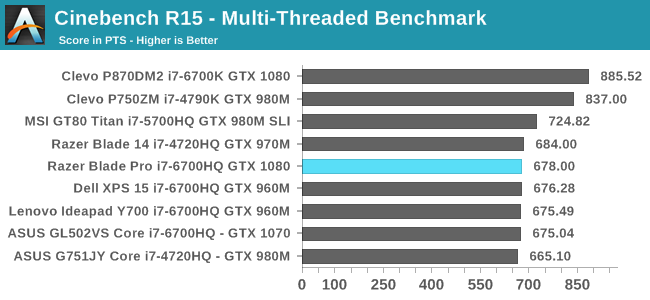
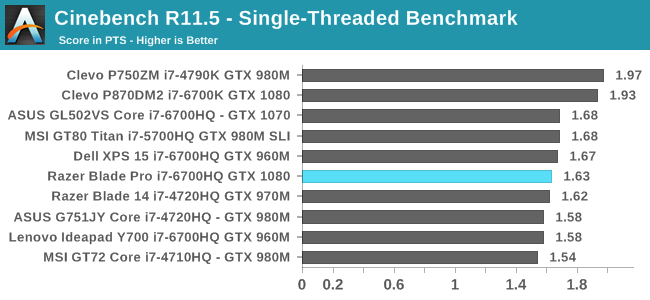
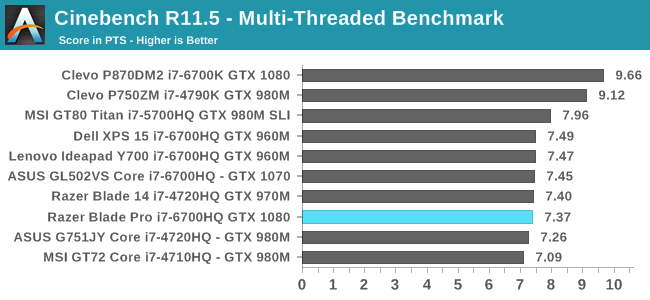
Cinebench is heavily cpu-focused, with both a single-threaded and a multi-threaded test. Previous devices that use Intel's Core i7-6700HQ have fallen in line with roughly the same scores, and the Blade Pro is no exception. However, it's worth noting that those other i7-6700HQ laptops can retail for less than half the price of the Blade Pro, and given the Blade Pro's position as an expensive no-compromise machine, using the 2.9GHz i7-6920HQ would have been a good way to outshine the competition in CPU-focused tasks and benchmarks. So while the Blade Pro does perform as well as similarly specced laptops, you would think that the high price would net you an advantage over the rest of the market.
Web Performance
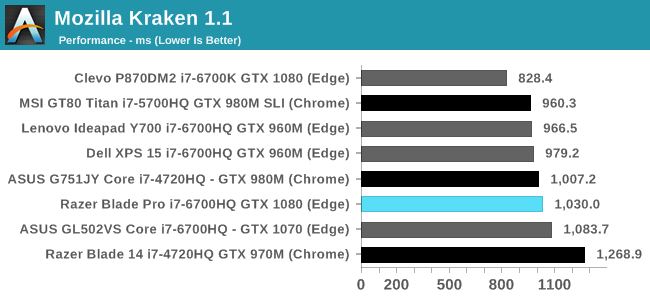

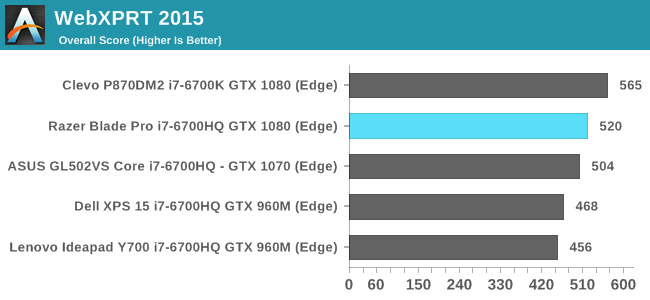
Like the CPU-focused tests, the JavaScript web browsing benchmarks really highlight a device's CPU performance. The testing has evolved here, with the default browser switching from Chrome to Edge when Windows 10 launched, so there is som variance here due to the browser. In this case the Blade Pro is in line with other i7-6700HQ laptops, and with tests like Octane the scores are so high that even a gap of 300 points could simply be due to testing variance.
Storage Performance
The Blade Pro comes in three different storage configurations of 512GB, 1TB, and 2TB. All of these involve two SSDs in a RAID0 configuration. At this point I really need to address this continued nonsensical trend in the gaming machine market. Using two SSDs in RAID0 is not advantageous; it actually presents problems. Using two separate SSDs takes up more space internally, which is at a premium in this kind of machine. It also essentially doubles the failure rate, because you now have two drives that could be a point of failure, and in this setup the loss of one drive is catastrophic. Finally, RAID0 doesn't improve performance in any meaningful way with SSDs. In this scenario the data is striped across both drives, but SSDs already implement multiple forms of parallelism internally, making this mostly pointless when you could just get a larger drive. This kind of setup boils down to marketing driving product decisions, and that's not a framework for good decision making.
Moving on to the actual drives, I've checked on both a 512GB and a 1TB unit that the drives in use are Samsung's PM951. I've heard from other people that their units use PM961, so it's not clear if some sort of multi-sourcing is going on here, but mine are definitely PM951 and I can only evaluate what I'm given. Regardless of whether it's PM951 or PM961, I'm really shocked to see a TLC drive in a $3700 laptop. Frankly, it's just not acceptable. One point I neglected to mention above is that using two separate SSDs in RAID0 instead of a single larger SSD increases the cost by about 20%. So effectively, money is being spent to check a box on a marketing sheet even though it doesn't provide any benefit to the user, when it could be spent on using an altogether better SSD.
At this point SSDs have gotten so fast that you'll usually be bottlenecked by some other part of the system before the IO performance becomes an issue. CrystalDiskMark isn't exactly comprehensive, but it gives a basic idea of SSD performance. Sequential read speeds surpass 2GiB/s, and sequential write speeds surpass 1GiB/s. My complaint is really just based on the fact that such an expensive laptop is shipping with anything but the best available SSDs. In this case the 1TB arrangement of two 512GB PM951s is actually slower with random read and write speeds than the Clevo P870DM2 outfitted with only a 256GB Samsung 950 Pro, despite the 950 Pro's overwhelming disadvantage with the number of dies for use with internal parallelism. For $3699.99 I would expect nothing less than Samsung's SM961, and I'm pretty sure Razer would still make a hefty profit on each unit if they used it.


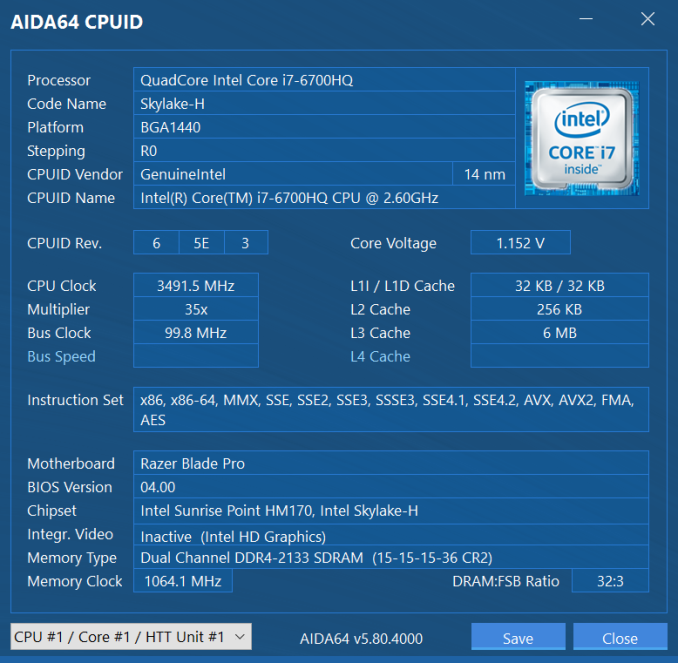
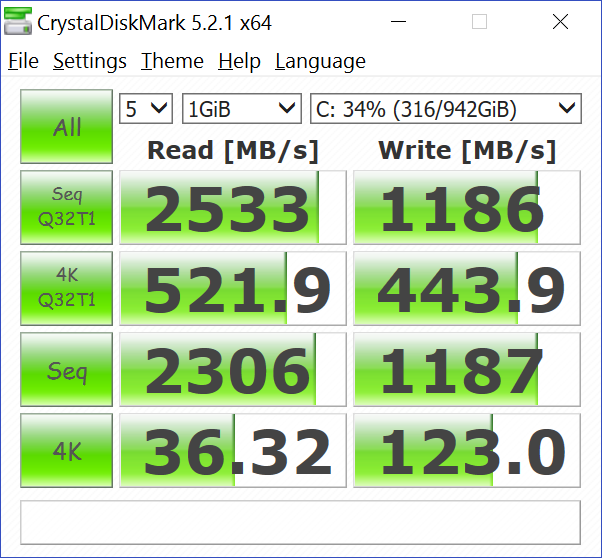








57 Comments
View All Comments
digiguy - Monday, March 6, 2017 - link
yes, it would have only impacted cost (and maybe to a limited extent noise)fanofanand - Monday, March 6, 2017 - link
It would have impacted Razer's margins, nothing more. This is a cool laptop and all, but it's maybe $1500 worth of parts (for the $3800 version) with a massive markup.fanofanand - Monday, March 6, 2017 - link
Ok maybe $2,000. I just did a quick rundown of the BOM in my head, and even without Razer getting a sweetheart deal on any of the components (which of course they do) and the BOM is $2000-$2200. Either way there are margins there that Razer is I'm sure very pleased with. Even at this stratosphere It's probably harder to sell a $5k laptop than it is a $3k laptop, so they cut corners here and there. The reviewer aptly pointed out that the CPU and screen appear to be the two corners that were cut (and the stupid killer NIC).erple2 - Wednesday, March 8, 2017 - link
The screen is actually quite good, as evidenced by the calibrated results. In face, it's exceptional. The problem is that Razer went on the cheap and didn't calibrate it at the factory. That's not hard to do in a large production plant. If a $650 iPhone can have a very accurate screen and make a handsome profit margin, a $3000 laptop can easily, too.fanofanand - Monday, March 13, 2017 - link
The difference is that Razer is not the OEM for any of the components in their laptops, whereas Apple is vertically integrated to the point where they are making their own SOCs (even if they are fabbed elsewhere). What Apple does is vastly different than what Razer does. End users (at least 99.9% of them) would not calibrate their screen. Sure, professionals who need color accuracy would, but most people won't. That's why it's so important for these companies to do the calibrations ahead of time, so the end user can just buy the thing, plug it in, and be wowed.mobutu - Monday, March 6, 2017 - link
It's unacceptable for a modern machine to have those kind of bezels.DanNeely - Monday, March 6, 2017 - link
chassis size is set by the needed component and cooling volumes on this class of laptop. That means the only way for smaller bezels would be to use a bigger panel. Unfortunately the next bigger size, 18.4" is far more niche than even 17.3" (in conventional gaming laptop form factors it's almost exclusively used for SLI models); which means that Razer might not have been able to source a good high DPI panel. Assuming not, 1080p TN would be even worse.prophet001 - Monday, March 6, 2017 - link
Too much thermal throttling.You can't dissipate enough heat out of that laptop for a 1080.
jsntech - Monday, March 6, 2017 - link
Hey guys - we're at six months post-launch for the 2016 MBPs. I saw a comment a couple/few months ago about Ryan finishing up the review back then and am surprised it's taken so long to publish. Other outlets have obviously long since put up their reviews but have sadly (and as usual) fallen short of the detail I enjoy from AT reviews. Will we see it anytime soon? Are/were there issues with review samples, etc., or ?Aman5ingh - Tuesday, March 7, 2017 - link
"As time has gone on, Razer has iterated on the original Razer Blade, and introduced both a smaller model in the form of the Razer Blade Stealth, a 14-inch model to carry on the name of the original 17-inch Razer Blade..."Nope, the 12.5" model is called the Stealth (Intel HD Graphics), the 14" model is called the Razer Blade (which has a GTX 1060), and this one is the Pro.